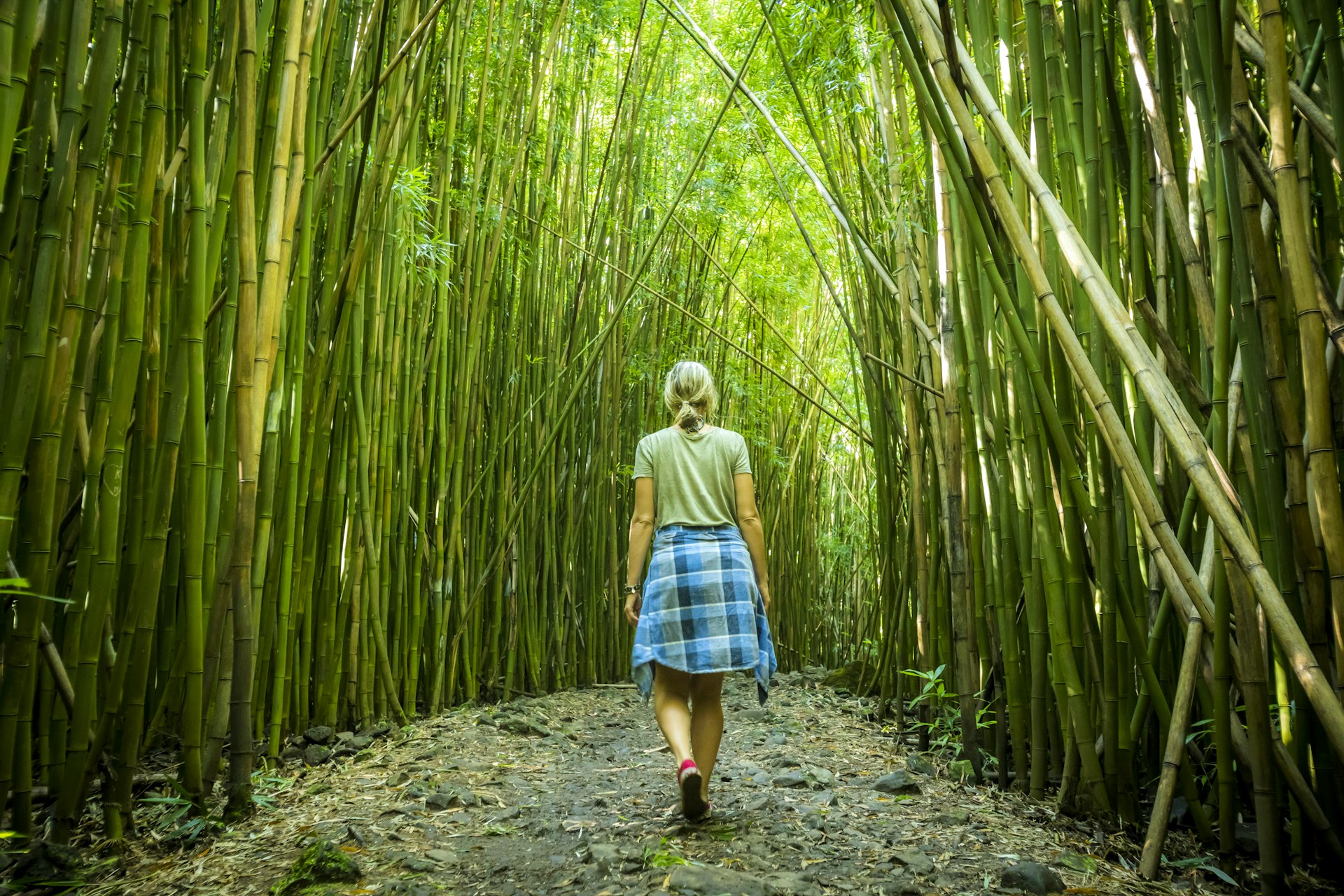
There’s no better way to explore Hawaii than by hitting one of the dozens of hiking trails that weave across the state.
Trekking here can mean an escape into a native rainforest or cutting along secluded coastal trails. Indeed, the diverse range of trails in Hawaii can give visitors a true appreciation of the islands’ natural beauty.
Immerse yourself in the best experiences the world has to offer with our email newsletter delivered weekly into your inbox.
Despite Hawaii accounting for less than 0.2% of the land in the USA, more than a quarter of species found on the nation’s endangered species list are endemic to the state. Hiking is one of the best ways to see some of Hawaii’s endangered plants and animals, whilst also experiencing its unique ecosystems
From strolls along secluded shorelines to walks across volcanic landscapes, there are hikes for all abilities, including first-timers and families, too. These are the 15 best hikes in Hawaii.
 The Makapu’u Point Lighthouse Trail is a great first hike to try in Hawaii © Rosanna U / Getty Images
The Makapu’u Point Lighthouse Trail is a great first hike to try in Hawaii © Rosanna U / Getty Images
1. Makapuʻu Point Lighthouse Trail, Oʻahu
Best for beginners and parents with strollers
2 miles round trip, 1 hour, easy
Leading to a historic lighthouse on Oʻahu, this is easily one of the most scenic – and accessible – hikes on the island. Perched on a 600ft-high sea cliff on the easternmost point of the island, Makapuʻu Point Lighthouse was built in 1909. The mile-long trail that leads to the red-roofed lighthouse was recently renovated and is entirely paved, making it a great option for non-hikers, pets, and strollers.
Avid hikers love this trail too. It meanders along windswept cliffs with stunning views of the rugged Kaiwi Coast and the Pacific Ocean. In the distance, you can see the offshore islets Manana and Kaohikaipu, as well as Molokai, Maui, and sometimes Lanai on clear days. Hike the trail between November and May and you’ll likely spot some of the 12,000-odd North Pacific humpback whales which swim down to Hawaii from Alaska to mate, play, and give birth in the warm, shallow waters around Oʻahu.
For the more adventurous, you can walk to the tide pools below – the trailhead is located just after a lookout with whale information signs. Check ocean and wind conditions and be careful of big surf crashing onto the ledge.
2. Kaiwa Ridge Trail (a.k.a. the Lanikai Pillbox Trail), O‘ahu
Best sunrise hike
1 mile, 1 hour, moderately difficult
If you want to catch the sunrise over one of the most beautiful beaches in Hawaii (and arguably the world), head to Lanikai on Oʻahu’s Windward side. The Kaiwa Ridge Trail – more commonly known as the Lanikai Pillbox Trail – is a 1-mile, mostly uphill trek to two concrete pillboxes (observation stations build in early 1943). From the top, you can watch the sun rise above the gorgeous Lanikai Beach and the famous Na Mokulua (‘twin islands’).
There’s no parking at the trailhead. Park at Kailua Beach Park instead (it has restrooms and showers) and walk five minutes to the start of the trail. It’s hot and often crowded on this trail, so hitting it early for sunrise is highly recommended.
 The 200-acre Koko Crater Botanical Garden Loop is great for nature fans © Leigh Anne Meeks / Shutterstock
The 200-acre Koko Crater Botanical Garden Loop is great for nature fans © Leigh Anne Meeks / Shutterstock
3. Koko Crater Botanical Garden Loop, Oʻahu
Best hike for nature lovers
2 miles, 1 hour, easy
This may be a municipal green space but the 200-acre Koko Crater Botanical Garden in East Honolulu offers a nice, unpaved 2-mile loop trail through its collection of rare and endangered dryland plants. Hikers will pass golden barrel cacti, native loulu palms, baobabs, and succulents. There is also a huge grove of plumeria trees right at the front of the garden, too. Trek here in the summer when hundreds of its trees are in bloom.
4. Kaʻena Point Trail, Oʻahu
Best hike to see wildlife
3.5 miles, 3 hours, easy to moderate
The Kaʻena Point Natural Area Reserve on Oʻahu’s westernmost end represents one of the last intact sand dune ecosystems in the main Hawaiian Islands. It’s home to native coastal plants like the dwarf naupaka and ilima, and seabirds, including the Laysan albatross, wedge-tailed shearwaters, red-footed boobies, and the great frigate bird.
A 3.5-mile, well-graded trail to Kaʻena Point runs through this nature preserve, hugging the rugged coastline with near-constant views of the Pacific Ocean. You can often see dolphins and migrating whales (in the winter months) here, and endangered Hawaiian monk seals and Hawaiian green sea turtles sometimes rest on the shoreline.
The trail follows an old railroad bed to this remote and scenic area. But it also holds great cultural significance to Native Hawaiians. Kaʻena Point is known as leina-a-kauhane, the leaping place of souls, where the spirits of the recently dead could be reunited with their ancestors. It’s a very sacred spot.
There are two ways to get to Kaʻena Point but start on the Waianae side. The trailhead is located at the end of a paved road near Keawaʻula Bay (Yokohama Bay), one of the most picturesque beaches on the island. It also has a parking lot.
 The rewarding ‘Akaka Falls are like something out of a time capsule © Janice Wei / Getty Images
The rewarding ‘Akaka Falls are like something out of a time capsule © Janice Wei / Getty Images
5. ʻAkaka Falls Loop Trail, Hawaiʻi Island
Best accessible waterfall trail
0.5-mile round trip, 30 minutes, easy
If you want to see a gorgeous waterfall but don’t have a lot of time or brought the wrong shoes, try the easy ʻAkaka Falls Loop Trail. Located about 20 miles north of Hilo, inside the ʻAkaka Falls State Park, this short walk along a paved path leads hikers through lush tropical vegetation to two waterfalls, including the dramatic 442ft ʻAkaka Falls.
It takes less than 15 minutes to get to the viewing area, and the walkway has railings. The area can be rainy, especially in winter and spring, so the path may be slippery. But that’s really the only hazard. As with other state parks in Hawaii, there’s now a fee to enter: $5 for non-residents.
6. Ehukai Pillbox Hike, Oʻahu
Best for views of Oahu’s North Shore
2 miles, 1 ½ to 2 hours, moderate
Oʻahu’s fabled North Shore boasts some of the world’s best surf breaks and the 2-mile Ehukai Pillbox Hike climbs the side of the northern Koʻolau Mountains to WWII bunkers that have sweeping views of those beaches. It’s a great alternative to the more-crowded Kaiwi Ridge Trail, which overlooks Lanikai Beach in Kailua.
The trailhead starts in the parking lot of an elementary school, though you can park on the street, too. The first half of the trail is a steady ascent along tree roots, stumps and man-made stairs dug into the dirt trail – it’s often muddy. At the top of this hill, go left and walk through ironwood trees until you reach the first of two bunkers. The second one has better views.
From the top, you’ll nearly get a panoramic sweep of the entire North Shore coastline, including the famed Banzai Pipeline surf break and Sunset Beach. Surrounding you is the 782-acre Pupukea-Paumalu Forest Reserve, which you can also explore.
 Hawaii’s Kilauea Iki Trek is like no other hike on earth © Maridav / Shutterstock
Hawaii’s Kilauea Iki Trek is like no other hike on earth © Maridav / Shutterstock
7. Kīlauea Iki Trek, Hawaiʻi Island
Best for volcano lovers
4 miles round trip, 2 ½ hours, moderate to difficult
One of the most popular hikes in Hawaiʻi Volcanoes National Park, the 4-mile Kilauea Iki trek starts in a forest of native ohia trees and hapuu fern and ends by passing through an otherworldly desolate crater floor. It’s one of the most unique hikes in Hawaii. Kilauea crater was the site of a spectacular, short-lived eruption in 1959 that produced some of Kilauea’s most amazing lava fountains of the 20th century, including ones that reached 1900ft. The lava lake would fill with molten lava, then drain into the vent, leaving a prominent black ledge, similar to a bathtub ring, which can still be seen on the crater walls today.
The walk across the cracking pahoehoe rock across the crater is the highlight of this hike. It stretches for a mile and is some 3000ft across. It’s now dotted with small ohia trees and kupukupu fern growing from cracks in the lava rock. The trailhead is inside Hawaii Volcanoes National Park. It costs $30 for a seven-day entry pass for cars or $15 per person for those walking in.
8. Kuliouou Ridge Trail, Oʻahu
Best for mountain views
5 miles round trip, 3 hours, moderate to difficult
There’s a reason why this 5-mile round trip hike in East Honolulu is so popular, especially among residents: it ends at the summit of the Koolau Mountains with a 360-degree view of Windward Oʻahu and the island’s south shore.
The trail starts with switchbacks through ironwood trees and groves of Cook pines, large coniferous evergreen trees native to New Caledonia. This part of the trail is mostly shaded. You’ll reach two covered picnic tables – a great place to stop for lunch, and often the turn-around point for some hikers.
The next part of this trail is challenging, even for avid hikers. It meanders through native ohia and koa trees, with the final ascent to the summit marked by man-made stairs. There are about 300 steps to the top, some steeper than others. But the payoff is a panoramic view of Kailua from 1700ft, with vistas of the Mokulua Islands, Waimanalo, and Hawaii Kai.
Like many state-run trails, this one is tucked away in the back of a neighborhood, with no designated parking area. So you’ll have to find street parking, which can be difficult on weekends.
 Woman exploring bamboo forest while hiking Pipiwai trail in Haleakala National park © VisualCommunications / Getty Images
Woman exploring bamboo forest while hiking Pipiwai trail in Haleakala National park © VisualCommunications / Getty Images
9. Pipiwai Trail, Maui
Best waterfall hike
4 miles round trip, 2 to 3 hours, moderate
The Pipiwai Trail isn’t easy to get to. It’s located in the Kipuahuku district past Hana, a rural town 52 miles from Kahului on Maui’s eastern coastline. The trail starts near the Haleakalā National Park visitor center with an uphill push to an overlook of the far-off Makahiku Falls.
The pathway is large and well-maintained, with ample signage. You can extend the hike with a stroll on the short Kuloa Point Trail, which overlooks a series of freshwater pools in the Oheo Gulch. The highlight is the 400ft Waimoku Falls but the most memorable part is the hike is over a boardwalk through a dense bamboo forest. It’s a magical experience.
10. Kalōpā Nature Trail, Hawaiʻi Island
Best easy rainforest hike
0.7 miles, 1 hour, easy
Few venture to the 100-acre Kalōpā Native Forest State Park on Hawaiʻi Island, some 40 miles north of Hilo. But if you’re looking for some solitude, this is where to find it. Located on the windward slopes of 2000ft-high Mauna Kea, the Kalopa Nature Trail is an easy walk through a lush and enchanting rainforest, surrounded by large ohia trees and other native forest trees, shrubs and ferns. It’s a great hike for families and anyone looking for an escape into the forest.
There’s no fee to enter the park for day hiking. Due to its elevation, the park gets a lot of rain and is much cooler than coastal areas. The trail is often wet and muddy, so bring wet weather gear, sturdy shoes, and mosquito repellent.
 Steep but doable, the Waihee Ridge Trail is a spectacular day hike © Maridav / Getty Images / iStockphoto
Steep but doable, the Waihee Ridge Trail is a spectacular day hike © Maridav / Getty Images / iStockphoto
11. Waihee Ridge Trail, Maui
Best day hike
5 miles round trip, 4 hours, moderate
This 5-mile hike explores the wild West Maui Mountains, with a steady climb through native rainforest and views of Wailuku and central Maui from the 2500ft summit.
A well-maintained path leads hikers through groves of guava and eucalyptus trees, Cook pines and dozens of native plants and trees that prefer a wetter mountain habitat. Early on you will be greeted with a great view of Makamakaole Falls, a 270ft, two-tiered waterfall.
It is worth the difficult uphill effort to get to the end as from the summit you’ll see the complex topography of the West Maui Mountains and views of Maui’s north shore and the lush Waihee Valley. Hit this trail in the morning, as clouds can form later in the day, obstructing your view.
12. Waihou Spring Trail, Maui
Best for families
1.8 miles, 2 hours, easy
Kids love exploring the Waihou Spring Forest Reserve in Upcountry Maui. The easy Waihou Spring Trail follows an old forest road through Cook pine, cyprus and eucalyptus trees planted in the 1920s.
The state-run Waihou Spring Forest Reserve was established in 1909 to protect one of the few perennial springs on the west slope of Haleakalā. The loop trail follows a ridgeline, then descends into a gulch. Along the way, you’ll walk through native koa and hala pepe, a species found in the Hawaiian dryland forest that sprout green pom-poms of leaves atop its slender trunks.
More adventurous hikers can continue down the lower trail, which snakes down to Waihou Spring. It’s a 600ft descent to a tranquil grotto carved out by the spring and the walk is a little more strenuous than the upper section.
 Summiting Nounou Mountain is a popular hike in Hawaii © Matthew Micah Wright / Getty Images
Summiting Nounou Mountain is a popular hike in Hawaii © Matthew Micah Wright / Getty Images
13. Summiting Nounou Mountain (Sleeping Giant), Kauaʻi
Best hike with views of East Kauaʻi
6.1 km (3.8 miles) round trip, moderately easy
Visible from anywhere in Kapaʻa, the trek up Nounou Mountain (Sleeping Giant) is one of the most popular hikes on the island. This is because it’s not crazy-difficult and it offers unrivaled views of East Kauaʻi and its coastline.
There are three trails snaking up the emerald ridgeline, the East Trail is the most popular and least difficult. The ascent starts with several switchbacks through a forest of waiawī (strawberry guava) trees, ironwoods, and kī (ti) plants that end at a grassy meadow with a picnic table. The view here – of Waiʻaleʻale and the Wailua River– is incredible. More experienced hikers can continue on to the summit, which offers 360-degree views of Kauaʻi’s beautiful eastern side.
Tips for hiking in Hawaii
- A hat, sunscreen, and lots of water are always mandatory. Coastal trails can bake you to a crisp and cause heat exhaustion or life-threatening heat stroke, especially when walking across sun-reflective lava.
- If you’re looking to spend hours (or days) on the trail, bring hiking boots and rainproof clothing – weather is changeable, and trails can be rocky, uneven, and muddy.
- If you’ll be tackling a mountain summit, carry a fleece or down jacket (even in summer).
- Always bring a flashlight. It gets dark fast after sunset, and trails can take longer than expected to finish due to the uneven terrain or accidentally getting lost.
- All freshwater – whether flowing or from a pond – must be treated before drinking to avoid giardiasis and leptospirosis.
- Depending on the hike, potential environmental hazards range from vog (volcanic smog) to flash floods and waterfalls, which are not always safe for swimming.



